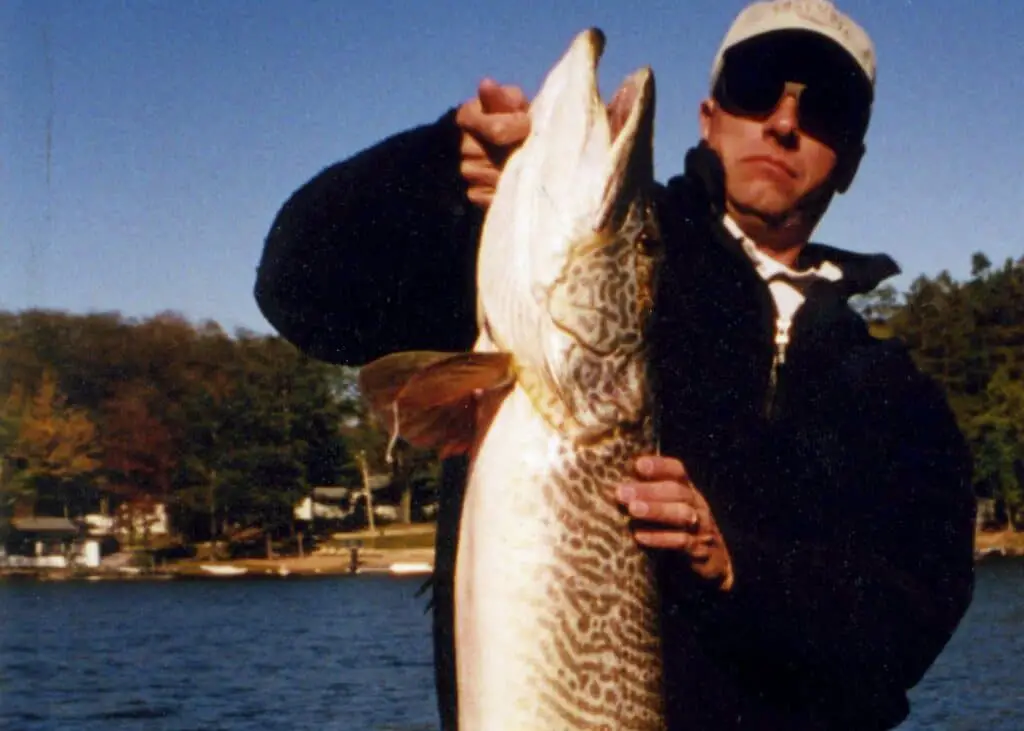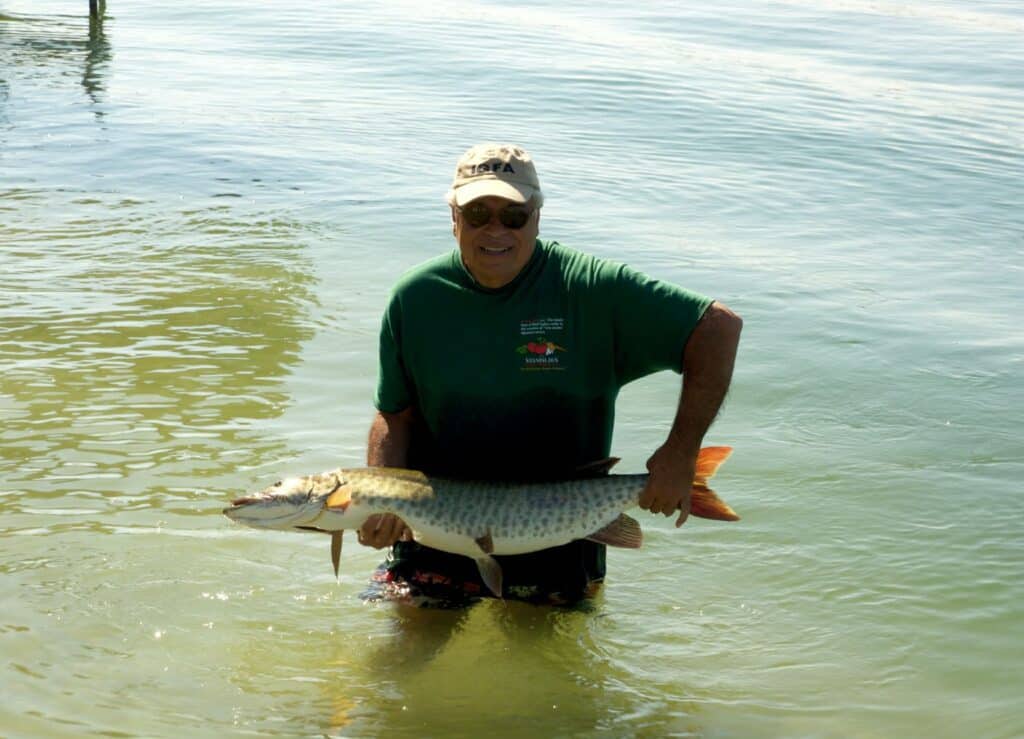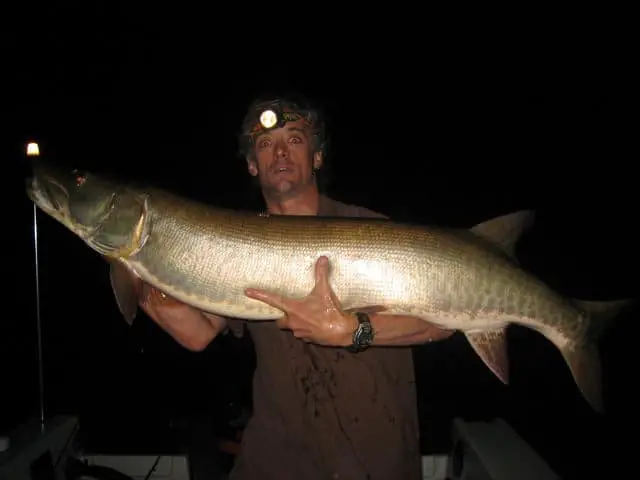Muskies and tiger muskies are some of North America’s most popular freshwater fish. Unless you know where to pursue them, it can feel like you’re after a mythical creature instead of something to put on the fire for dinner.
What makes muskies such a unique species is their predatory appearance and physical structure. If you were to catch a glimpse of one in the water, you might think it was a small barracuda!
Razor-sharp teeth are what predators use in the water to catch and consume prey. If you’ve ever seen the mouth on muskies, you know that hundreds of them are waiting to be found.
The average adult muskie and tiger muskie can have up to 700 teeth in its mouth for you to manage. The largest of them can be up to an inch long, with numerous needle-like smaller ones in there to complement the canines.
What does that fact mean for anglers? For starters, it says that a muskie won’t get caught with mono or braid because the fish will bite right through it.
Where Can I Find Muskies?
The muskellunge is the largest member of the Esocidae family of fish, which is where you can find all pikes. It is native to all North American freshwater reserves, although you’ll find the species in about 50% of U.S. states.
This fish gets its name from the ancient tribal languages found in the United States and Canada. The Algonquin word for the species is “maskinunga,” while the Ojibwe called it “maashkinoozhe.” Both of those terms roughly translate to “big fish.”
Some people call this species “lunges” instead of “muskies” by abbreviating the end of the word instead of the beginning.
According to old fishing stories, some muskies can get to be eight feet long. Although this trait hasn’t been documented in modern history, several examples near 60 inches are in the records.
The IGFA all-tackle world record for muskies was set in 1949 near Hayward, WI, for a fish that was 60.25 inches long and weighed over 67 pounds. In 2019, a catch-and-release angler reported a 61.5-inch muskie in Mille Lacs.
It is not unusual for muskies to get stocked in freshwater areas to support recreational fishing opportunities. These predators can also balance out habitats to restore homeostasis to the environment, which benefits everyone.
How Many Teeth Can Be Found on a Tiger Muskie?
When you open the mouth of an adult muskie, the canine teeth are the ones that stand out immediately.
You’ll find numerous sharp teeth protruding from the outer jawline on both sides. Approximately ten long canines protrude upward, with several smaller ones lining the jaw’s front and back.
It’s the upper palate that impresses anglers the most when catching a muskie or a tiger muskie for the first time. You can see two long “strips” of teeth that run along the upper part of the mouth, with several teeth the size of the lower canines there to start munching on their prey.
You can even find teeth on the tongue of the fish!
Although the estimate is that an adult muskie or tiger muskie has up to 700 teeth to use, that figure could be doubled for some individuals. That’s why you’ll want to be careful handling this fish if you manage to catch one.
If you start fishing for muskie, you’ll need a strong wire leader to prevent a bite-off from happening. The best options are made from solid titanium and offer a 40-pound capacity to haul in the biggest muskies where you’re fishing.
The Teeth Are Angled Inward on Muskies
A muskie’s small teeth grow on “pads” within the mouth. You’ll see them angled inward at a slight angle instead of being completely vertical.
This structure prevents the prey fish from escaping after being captured by the muskie or the tiger muskie. It also gives them an advantage because the shape naturally turns the food so that it moves headfirst into the throat, preventing another potential escape route.
The razor-sharp teeth can lacerate almost any soft tissue instantly. When they engage the mouth pads with the hundreds of teeth, short work is made of virtually any meal.
The more prominent teeth on the muskie or the tiger muskie are the primary hunting tool the fish uses. The canines are meant more for grabbing and holding prey instead of chewing it.
Anything smaller than the muskie won’t escape once those jaws come down. That’s why they can be such a challenge for anglers to catch.
The tooth design is a unique asset. Although these predators rely on fish schools for their diet, they can eat almost anything that comes within striking range. Anything in their ecosystem is a food source, including frogs, mice, rats, and insects.
It is even reported that muskies have attacked larger animals while hunting, including ducks and muskrats. Even small dogs won’t escape the possibility of being a meal if a hungry muskellunge is in the area.

Differences Between Muskies and Tiger Muskies
The easiest way to tell if you’ve got a muskie or a tiger muskie is to look at its tail. If you have a true muskellunge, the fins split out to two points. This fact remains no matter what the body coloration is on the individual you’ve caught.
A tiger muskie’s tail splits into two rounded portions instead. That makes it look closer to a northern pike than a muskellunge
Muskies and pikes have pores on the underside of their jaw to detect nearby vibrations in the water. If you carefully flip the fish over to examine it, you’ll see at least six on either side of a muskellunge. When there are five or fewer, that means you’ve caught a northern pike.
Another way to tell the difference between the two fish is to look at their stripes and spots. Muskies have vertical bars that range from olive to dark gray, while juveniles might trend to something silvery.
Tiger muskies have darker spotting patterns that tend to develop vertical “striping” when seen from afar. You’ll also see the unique look extend to the fish’s fins, whereas a regular muskellunge has fins without much patterning at all.
Since these fish are sometimes cannibalistic, it’s not always easy to tell what you’ve caught by the fins alone. It’s not unusual to have them injured or damaged to the point where a significant portion of it could be missing.
Why is it challenging to tell the differences between muskies, tiger muskies, and northern pike? If you catch a tiger muskie, you’re getting the offspring from a muskellunge and a northern pike. It’s a hybrid species.
Interested in some other fish with scary teeth? Read “Fly Fishing for Golden Dorado.”
Do Tiger Muskies Shed Their Teeth or Lose Them?
It is not unusual for people to confuse the northern pike with muskies and tiger muskies.
Northern pike is also a freshwater predator fish, but the adults are usually solitary individuals. They’re also highly territorial.
That approach to living causes them to weigh over 60 pounds when fully grown. When compared to muskies and tiger muskies, you’ll see a more pointed face and mouth.
The spotted pattern on a northern pike is also different than what you find on muskies.
Another difference between muskies and northern pike involves the fish’s teeth. Northern Pike shed their teeth to grow new ones throughout their lifetime. That doesn’t happen for muskies.
The muskie’s teeth continue to grow from the top and the bottom. You’ll see the size wear down some as the fish bites into bony prey, but that’s the extent of what happens to the larger teeth.
Some anglers say that they’ve caught muskies with teeth much more extensive than one inch. In 1998, the lower jaw of a muskie was recovered in Wisconsin that showed teeth that were 1.5 inches long.
If you’re talking about muskies found in the Great Lakes, the giant predators that stay away from anglers could conceivably have razor-sharp teeth up to three inches long.
Muskies can lose their teeth, but this event usually happens because they break off from feeding behaviors or attacks. It is also believed that the fish have the teeth fall out as they get older, which explains why some anglers catch some individuals that only have a few teeth in the mouth.
Do Muskies Attack Humans?
If you were to get bit by a muskie or a tiger muskie, it wouldn’t be a pleasant experience. Several anglers can tell you stories about trying to unhook lures from inside the mouth, only to discover how sharp those teeth are.
You can lose a substantial amount of your skin when bit by a muskie. If your fingers got caught in the mouth in the right way, it’s conceivable that amputation could occur.
If you’re fishing for muskie or tiger muskie, you’ll want to bring a jaw spreader with you to manage the hook and lure removal. When that equipment isn’t available, some pliers are better than your fingers.
Most muskies won’t attack humans in their natural environment because of the size differential between them and us. If they feel threatened because you’re in their territory, the result could be different. Scuba divers are known to encounter an aggressive muskie or tiger muskie every so often.
It can be a different story for children. In 2017, an 11-year-old girl dangled her feet from her paddleboard when a fish (probably a muskie) attacked. She said she kicked it with her other one, but it left 25 cuts when it disengaged. Some of the lacerations were deep enough to require stitches, and she had to undergo surgery to repair a tendon.
The incident happened on a lake where anglers regularly catch muskies that are over 50 inches in length.
It is rare for muskies and tiger muskies to attack swimmers. When these incidents happen, it is usually because the fish was distressed for some reason.
In 2020, a muskie attack in Missouri happened when a kayaker dangled his foot over his craft. He was left with a V-shaped row of punctures after the incident. The kayaker said he saw the 30-inch muskie go back into the deep water.
An angler who saw the incident said, “People spend hours and hours trying to catch one of these, and here he got bit by one.”
It was the first known muskie attack that happened in the state.
In a more dramatic story, a Canadian woman reported that a muskie bit her leg and dragged her underwater in front of witnesses. She was taken to the hospital to have her cuts treated.

What It Takes to Catch a Muskie or a Tiger Muskie
You’re going to need some specific gear to catch a muskie. An average pole with a lightweight line won’t stand up to the strength of this fish.
Even if you were to catch one that didn’t bite through the line, your rod would likely snap at the first sign of a fight.
That means you’ll need to invest more into your equipment to pursue this mysterious species. You’ll find higher prices waiting for you on the rods, reels, lines, and baits. If you compromise on your gear quality, you’ll find it costs more to keep replacing the cheap stuff than to buy the best items in each category.
Wondering what the most popular type of fishing is? Click here.
Here are the items you’ll want to have available when you start casting lines to catch muskies or tiger muskies.
Release Tools
Whether you catch-and-release or need to retrieve your gear, you’ll need a few tools to complete this task safely.
- Jaw spreader that accommodates muskies.
- Needle-nose pliers.
- Bolt and hook cutters.
- Protective gloves that stop tooth penetration.
- A muskie bumper.
Fishing Rods
Some anglers prefer to use different rods for each species they pursue. Others like to have something closer to a one-size-fits-all solution. Many fishing gear companies make rods specifically designed with muskie or pike in mind.
- Redington Predator Musky Fly Rod – This fast action 10 or 11 weight rod from Redington is ideal for predators like muskie or northern pike. Check the Trident Fly Fishing price here. You can also check the current Amazon price here.
- St. Croix Imperial Saltwater Rod – Although listed as a saltwater rod, this medium action rod would work well for freshwater predators. This rod is offered by Trident Fly Fishing and from Amazon. See the links for current pricing.
- G. Loomis IMX-Pro Muskie Fly Rod – If you plan on fighting a muskie, the G. Loomis IMX-Pro Muskie Fly Rod is what you want. G Loomis claims their action is “shoulder saving.” The fighting butt will help as well. Get the price over at Trident Fly Fishing.
Fishing Reels
You’ll get what you pay for when shopping for musky fishing reels today. If you take care of your investment, you’ll find it will last much longer as you pursue this sometimes tricky species. If you are looking for a conventional reel, the Shimano Tranx 500 offers the comfort you get with a low-profile design. You’ll find that there is nothing out of your reach when using this product.
If you’re fly fishing, check out the Redington Behemoth Fly Reel offered on Trident Fly Fishing.
Lines and Leaders
The average muskie and tiger muskie bait will set you back about $25. That’s why you don’t want your line and leaders to get snapped or damaged. Although you could try 100-pound braided line, the teeth can still cut through some products. That’s why your best option is a fluorocarbon tooth shield from Amazon. Or a stainless wire leader from Trident Fly Fishing.
What Is the Best Bait to Use for Muskies?
When you secure the equipment, you’ll want to grab muskie fishing baits with a successful reputation. Since there can be thousands of different examples that all claim to be the best product, knowing where to get started isn’t always easy.
Here are some of the best choices to consider so that you can have a successful fishing experience.
1. Glide Baits
Although this option is challenging to work with, it’s a practical investment that is useful at any time during the year. You’ll want to take some time to learn how to use it, but it will eventually increase the bites you receive. Since several styles are available to try, you might consider experimenting with a few of them to see which options you prefer.
2. Bucktails
This lure is arguably the most popular one amongst muskie and tiger muskie anglers. They produce water vibrations that the fish feels, triggering the predatory instinct. You can retrieve them at any speed, although local conditions will dictate what is possible. The best options in this category are either the Double 10 or the Double 9 blades.
3. Soft Plastics
It doesn’t seem like the muskie baits in this category would work, but you’ll be surprised at how effective they are for the price. If you can mimic a dying baitfish’s behaviors, it won’t take long for you to get a strike. The average muskie wants an easy meal instead of working hard for it, which means the Medusas and Bulldawgs can produce impressive results.
4. Miscellaneous Baits
When the other options don’t seem to be working well for you, several other choices are available in your pursuit of muskies. Swimbaits, jigs, and crankbaits are all easy to operate and reasonably affordable. When selecting something in this general category, you’ll want to find a product that offers realistic movement in the water. If you don’t trigger a strike, it won’t matter if the lure can stand up to the teeth.
How to Trigger a Muskie to Strike
When you cast a line for muskies or tiger muskies, you’ll want to try a technique called the “Figure Eight.”
Muskies are a predator, which means they pursue their prey before capturing it. If you can trigger their curiosity, you’ll have an easier time landing one.
When you drag your lure in a figure-eight motion, you’ll capture the fish’s attention. It helps to use broad, carrying sweeps at slow angles to get those big individuals thinking about an easy meal.
You can also catch a muskie on a fly. Find some great destinations for fly fishing here.
Can I Keep a Muskie After I Catch It?
If you look at most fishing and muskie forums, you’ll see a statement like this somewhere on the site: “Serious anglers don’t keep the muskies they catch.”
The truth about fishing for muskies is that the size limits you’ll encounter in most jurisdictions prevent you from keeping what you catch.
When you’re fishing along the Niagara or St. Lawrence Rivers for muskies, you’ll need to catch a 54-inch one or larger before you’re allowed to keep it. If you’re fishing inland waters, the minimum size requirement is 40 inches.
Since the average size of a muskellunge is between 28 to 48 inches long, you’ll need to know how to safely and correctly handle the muskies you catch to release them back into the wild. The only keepers are the above-average adults that dominate their freshwater territories.
Muskies might be at the top of the food chain with their size and razor-sharp teeth, but they can also die quickly if you don’t handle the fish with care.

Tips for Catch-and-Release Muskie Fishing
When you start fishing for muskies and tiger muskies, it is essential to think about the location where you’ll cast lines. Trolling in the shallow areas near the lake or river edges and in the weeds will give you better results.
Anything that seems abnormal to the water’s flow or structure, including boulders, openings, or points, will attract muskies.
Once you know where to start fishing, you’ll need to be aware of these crucial catch-and-release tactics to help preserve the species for other anglers.
- You must limit the time a muskie or a tiger muskie spends out of the water to under 30 seconds. If you want to get a picture with it, you’ll need to make sure it’s ready to go, and your partner knows how to use it before bringing the fish out of the water.
- If you can measure the length of the muskie in the water, you’ll avoid needing to have a wet bump board on the boat with you.
- When you hold a muskie, you’ll need to put four fingers under the gill flap without going into the gills. Your thumb on the outside should be where the covers meet. Hold it firmly there, with the other hand under the belly.
- Do not place a muskie in a vertical hold.
- When releasing a muskie into the water, it helps to hold the fish until it can swim away under its own power. That process should only take 30-60 seconds if you’ve done your catch-and-release work correctly.
10 Tactics for Catching Muskies and Tiger Muskies
Once you’ve figured out the location where muskies are likely to be, and you have the equipment needed for catch-and-release, it’s time to up your angling game with these tactics.
1. Key in on the edges of your freshwater environment when trolling deep. Shoals and brake lines tend to be the best places to find this species.
2. If you can let your lure hit off of a rock or bounce into them, curious muskies will have their prey instinct triggered.
3. Most muskies tend to follow the bait before striking it. If the figure-eight methodology isn’t working for you, consider altering the direction with 90-degree sweeps that look like the letter “L.”
4. You’ll want to fight the muskies to land them as quickly as possible. When they expend too much energy during the battle, the risk of post-catch mortality rises dramatically.
5. If you see baitfish in the waters where you’re fishing, there’s an excellent chance that predators are close behind. You’ll want to look for the congregation points in your area to see what might be waiting for you there.
6. It helps to keep your drags tight to ensure hook-ups occur. If you troll, it should be set so that the lines are pullable by hand without much difficulty.
7. Vary your presentation speeds until you find where the muskies are waiting. Erratic casting is known to trigger strikes.
8. Muskies need oxygenated water to perform their best. That means you’ll want to look for the places where the coldest temperatures are to find the best options. When you fish in warmer waters, you won’t find as many opportunities to pursue this species.
9. It takes time on the water to catch muskies. When you’re out there more often, you’ll find that more opportunities to land something develop.
10. Muskies tend to be more active when the moon reaches its significant phases each month. Many anglers report that abrupt changes to barometric pressure can also increase their activity. If you can schedule time on the water during these events, your success rates might increase.
It also helps to speak with local anglers about what they’ve found to be successful when looking for muskies. Their advice can significantly reduce your learning curve.
What Should I Do If I Get Cut By a Muskie?
If you get bitten by a muskellunge when fishing, you’ll want to treat the injury as you would any other puncture wound. The teeth can cause a significant bacterial transfer if you don’t act quickly, which means you’ll need to clean each cut.
The first step is to apply pressure to the area to stop the bleeding. Even if you experience a severe injury, a muskie bite won’t cause you to bleed out. It might take a few minutes of using firm, consistent pressure on the wound to get things to stop.
Once your body stops leaking blood, it’s time to rinse the injured area with clean water. If you inspect the wounds, you’ll see if any temporary stitching or fasteners are necessary to prevent additional bleeding. It helps to keep some superglue on the boat to manage this issue.
After cleaning the wound with water, apply a disinfecting agent to the injury. Alcohol wipes provide an excellent result, although it will sting uncomfortably when applies. You can also use anti-bacterial gels or pastes.
Once it is clean, wrap the wound with a sterile bandage to prevent anything else from getting into the cuts. If you want to keep fishing, it might help to have a plastic cover to protect the area from getting wet.
Do People Save Muskie Teeth as Souvenirs?
If you have ever caught a muskellunge that you kept or encountered a skeleton in the wild, you might have seen those sharp teeth in person.
Some people keep musky teeth because they’re large and unusual for a freshwater fish.
Those teeth make muskies the top of the food chain in most freshwater environments. That means you’ll get a fish with attitude when you manage to hook one.
When you follow today’s best practices for catch-and-release, this resource is something you can reserve for your fellow anglers.
You should not save any muskie teeth if you practice catch-and-release.
Once you get the fish back in the water, you might get a splash from the tail as it swims off. Don’t get frustrated! That’s good luck for the next line you cast.
If you find this article helpful, don’t leave without sighing up for our newsletter and checking out our Recommended Fly Fishing Gear List.
Don’t forget to check out our other Fish Guide articles.
- Are Bass Good To Eat?
- What’s the Difference Between Trout and Salmon?
- Are Bonefish Good To Eat?
- What’s the Difference Between Carp and Buffalo Fish?
- Are Pike Good To Eat?
- The 7 Best Secret Rainbow Trout Baits
- Best Powerbait For Stocked Trout
- What Is The Difference Between Walleye And Pickerel?
- What Is A Tiger Trout? Where to Find One and How To Catch One
Featured image: “Muskies bite!” by David Comp via CC BY 4.0



